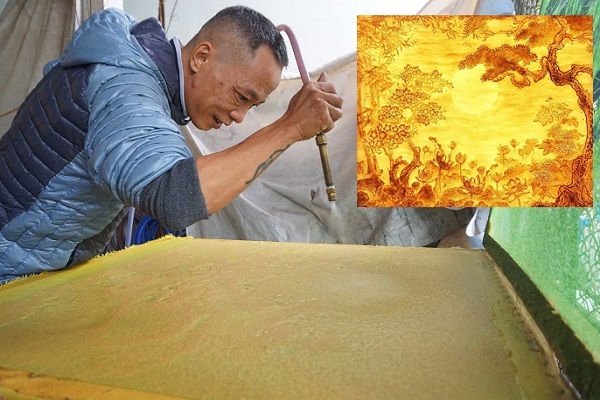
Le Dinh Nghien, a craftsman working on Cua Dong street in Hanoi, has been making Hang Trong paintings for the last 62 years. He is a third-generation craftsman from a family from Binh Vong Village that settled down in Hang Trong Village.
Le Xuan Que, the grandfather of Le Dinh Nghien, made Hang Trong paintings in the past. Nghien’s father, Le Dinh Lieu, handed down the art to his son, who was one of seven children.
Drawing in childhood
Nghien said he began drawing paintings when he was 11-12 years old. In 1972, the Vietnam Fine Arts Museum invited him to work for the museum. Its only request for Hien was to restore Hang Trong paintings at the museum. From that day on, he not only painted but also restored the Hang Trong folk paintings. He printed and repaired old paintings, and created new ones.
Even researchers are not sure when Hang Trong paintings began appearing, but they are sure they must have existed for a long time because Asian nations all have the tradition of hanging paintings on Tet days. The name Hang Trong painting refers to the address – Hang Trong street.
The golden days of Hang Trong paintings were in the late 19th and early 20th century, when the paintings were available in the large area of Hang Bo, Hang Non and Hang Trong streets. On pre-Tet days, Hang Trong paintings were displayed for sale on the sidewalks, creating a unique characteristic for Tet in Hanoi.
The special characteristic of Hang Trong paintings in comparison with other folk paintings lies in the technique. Unlike Dong Ho folk paintings, which use carved boards with shapes and colors, Hang Trong artisans use engraved boards made of soft wood. The color drawing is implemented after the brushwork is printed.
Colors in Hang Trong paintings are used very skillfully. With only six colors, the artist creates a world that is both brilliant and full of contrast.
The colors are the typical characteristics of Hang Trong’s paintings. There are rules for artisans to follow. There must be a balance between hot and cool colors which reflect the Yin and Yang balance in the Asian view of the world.
All the colors created by artisans are made of natural materials.
Hang Trong paintings are drawn with many themes, including worship paintings, Tet paintings and painting of characters in stories.
Preservation
Nghien said his work of painting and restoring folk paintings keeps him busy all year round, not just on pre-Tet days. The traditional art is still close to the Vietnamese people.
“Our family has preserved many woodblocks. I think that, as people still like this type of painting, we need to stick to the profession handed down by our ancestors,” he said.
Some people think that Hang Trong paintings are only for elderly people to recall the old days. But many young people, including those under 20 years old, show interest in the paintings.
“I meet a lot of young people who ask me about Hang Trong paintings and they can feel the warmth that the paintings bring,” he said. “Some of them bring their old Hang Trong paintings that have hung at their homes for decades, asking me to restore them.”
Now, as he is advanced in years, Nghien is teaching the art of HangTrong paintings to his son.
“Our family has been making paintings for many generations, but this profession requires meticulousness, perseverance, skills and great passion. It takes a long time to learn, and it’s difficult to earn a living with the profession. However, I still teach my son to preserve the folk beauty just like my father taught me,” he said.
In his small house on a small alley, many Hang Trong paintings are hung everywhere, including Tet, worship paintings, and works describing the festive life of the northern region, such as ‘Ca chep trong trang’ (Carp looks at the Moon), ‘To Nu’ (Virgin Girl), ‘Ngu Ho’ (Five Tigers), and ‘Tu Binh’ (Four female musicians).
The talk between reporters and Nghien was sometimes interrupted as people, both young and old, came to get their restored paintings.
Thai An

Dong Ho painting – art of daily life
For centuries, Dong Ho paintings were used as precious decorations to celebrate the Tet festival.

The man who turns waste into paper and paintings
For the last five years, Mr. Le Thanh Ha (Son Tra District, Da Nang) has been using branches of coconut palm to produce a special type of paper, which is then used to make paintings.